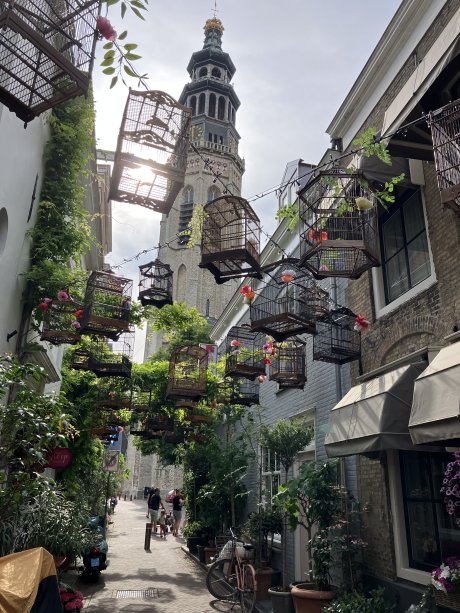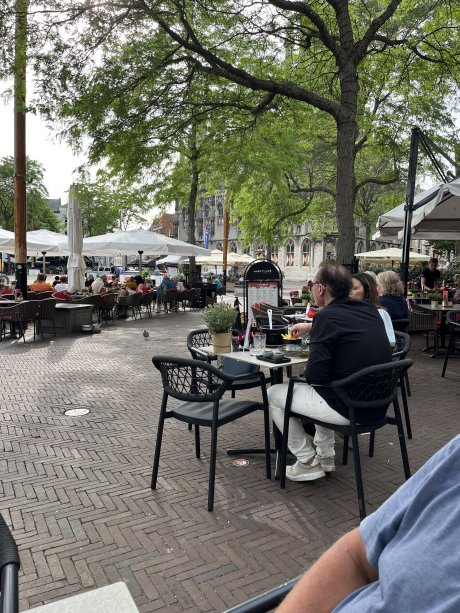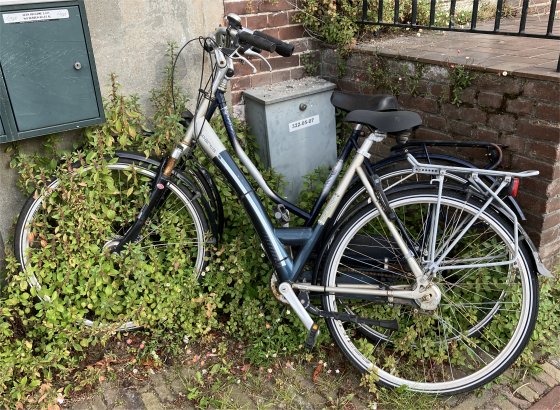 Long Straight Uitwateringskanaal Heading Inland from Cadzand Marina |
On my return I found Rex craning his neck towards action on one of the breakwaters; a photoshoot involving an attractive model. I hadn't seen him so perky for a long time.
After a breakfast of Weetabix and 0.5kg blueberries, I went for a short walk along the coastal path, eventually turning off back towards town along the Boulevard de Wielingen. In the corner of my eye, I spotted a tall telescopic crane. Its work had been completed, and I watched in amazement at the crane gradually folding itself up, un-telescopic itself (is there such a word?), and install itself on the back of its trailer, before being driven off to its next location.
 Cadzand Sluuswachter Gazing Out to Sea |
We had by now abandoned the idea of reaching Ijmuiden in order to continue our trip to Friesland. We had wasted a lot of time already, and besides, it would take days to coastal hop to that port anyway, assuming the weather would be benign to us. We decided instead to explore around the Oosterschelde; there were places we had not visited yet.
 Barge on the Westerschelde |
I chatted with the harbour master when I checked in properly. I was intending to pay our dues with cash, but he informed me that now it was card only. "Yes, some Dutch people want to pay by cash too, and some businesses prefer cash since it avoids tax issues," he informed me. "The Belgians and Germans always want to pay by cash for the back handers," he added.
It was a pleasure to return back to Middelburg - we were last here almost exactly a year ago. The historic town of Middelburg is the provincial capital of Zeeland. The town owes its name to the fact that it was Walcheren's central circular defences (burg meaning fort), a fortification built low down behind a circle of high embankments. These fortifications protected the residents from intruders, such as the Vikings. The first abbey was built in 844, and was replaced by a new one in 1125. Middelburg was part of the County of Zeeland, which was soon to be disputed by the Counts of Holland and those of Flanders. The city was granted city rights in 1217. In 1299, Holland and Zeeland both passed to the Counts of Hainaut, then to the Wittelsbach of Bavaria in 1345, to the Dukes of Burgundy a century later, and finally to the Habsburgs. The town continued to gain in power and prestige during the 13th and 14th centuries. In the Eighty Years' War (1568-1648) the northern provinces of the original Low Countries won their independence from their former Spanish Habsburg rulers and formed The Netherlands, a Protestant state. Later, in the 17th century (the Dutch Golden Age), Middelburg became, after Amsterdam, the most important centre for the East India Company of Republic of the Seven United Netherlands (VOC) or Dutch East India Company. Middelburg became a major trading city between England and the cities of Flanders (e.g. Ghent and Bruges), then, from 17th century, for the Dutch East India Company, the first international Corporate in the world. The small city had been the administrative capital of the province for a long time, but it had lost most of its attraction when other towns were booming during the last few centuries. Much of the city was destroyed by German bombing in May 1940, but most of the historical buildings were reconstructed afterwards.
 Heading Towards Lange Jan |
 Restaurant in Stadhuis Markt |
 Parallel Parking |
Meanwhile, a digger and road-sweeping machine were cleaning up the aftermath of a beach volleyball tournament on the square. Beach volleyball seems to be a popular activity across Holland. Despite the mechanisation, the workmen certainly had their work cut out.
